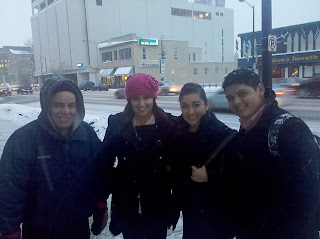Impact on the Local
Locally we must begin to educate immigrants on their rights so that they can understand how the law does protect them and so that they are not swindled by crooked lawyers or profiled by bad cops. We can begin by engaging them at their churches and schools with Know Your Rights Workshops (KYRW) and sign them up for updates and meeting reminders. We must take KYRW further by giving them hope through our stories of success in organizing. We must expand the number of local leaders engaged in these efforts if we wish to win a national reform in the near future.
 |
| TAP and students from various schools gathered seeking support from Councilman Oliver Davis for the DREAM Act. Councilman Davis delivered a powerful proclamation in support of the students. |
Impact Statewide
The attack on immigrant families will intensify because politicians see easy targets that can mobilize the electorate. We will see an Arizona style law, attack on Medicare for U.S. born children of immigrants, stronger penalties for entering the country without proper papers and workplace enforcement of the employees through e-verify. We must mobilize and visit our legislators in Indianapolis to share with them our values when dealing with immigrants and the consequences to our local economies if we make Indiana less welcoming to immigrants.
Impact Nationally
I wrote at the the beginning that the odds are grim for any positive reforms coming from Congress next year but I am hopeful. I am hopeful that we have learned our lessons well on how to move a national issue with a constituency that can not vote. We must build relationships with those that can vote and begin to work on common issues that impact our communities. We must stand with the working people in the non-immigrant communities that also want better schools, safer neighborhoods, access to health care and opportunities to economic development. We need their support because their voting power is what will bend the ear of elected officials.
 |
| Rev. Gilbert Washington of St. Paul Bethel Missionary Baptist Church, attending a DREAM Act march in downtown Chicago. |
So what can you do?
Join TAP to begin building bridges with non-immigrants and let us stand together to ensure our families are not the targets of opportunity seeking politicians this coming year. If you are interested in finding out more and staying informed, please contact us tapmichiana@gmail.com.
May God bless your families and Merry Christmas.
